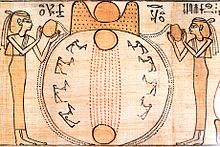Ancient Egyptian creation myths

| Part of a series on |
| Ancient Egyptian religion |
|---|
 |
|
|
Ancient Egyptian creation myths are the
In all of these myths, the world was said to have emerged from an infinite, lifeless sea when the sun rose for the first time, in a distant period known as zp tpj (sometimes transcribed as Zep Tepi), "the first occasion".[4] Different myths attributed the creation to different gods: the set of eight primordial deities called the Ogdoad, the contemplative deity Ptah, and the mysterious, transcendent god Amun. While these differing cosmogonies competed to some extent, in other ways they were complementary, as different aspects of the Egyptian understanding of creation.
Common elements

The different myths have some elements in common. They all held that the world had arisen out of the lifeless waters of chaos, called Nu. They also included a pyramid-shaped mound, called the benben, which was the first thing to emerge from the waters. These elements were likely inspired by the flooding of the Nile River each year; the receding floodwaters left fertile soil in their wake, and the Egyptians may have equated this with the emergence of life from the primeval chaos. The imagery of the pyramidal mound derived from the highest mounds of earth emerging as the river receded.[5]
The sun was also closely associated with creation, and it was said to have first risen from the mound, as the general sun-god Ra or as the god Khepri, who represented the newly-risen sun.[6] There were many versions of the sun's emergence, and it was said to have emerged directly from the mound or from a lotus flower that grew from the mound, in the form of a heron, falcon, scarab beetle, or human child.[6][7]
Another common element of Egyptian cosmogonies is the familiar figure of the cosmic egg, a substitute for the primeval waters or the primeval mound. One variant of the cosmic egg version teaches that the sun god, as primeval power, emerged from the primeval mound, which stood in the chaos of the primeval sea.[8]
Cosmogonies
The different creation accounts were each associated with the cult of a particular god in one of the major cities of Egypt:
Hermopolis

The creation myth promulgated in the city of
Heliopolis
In
Memphis
The Memphite version of creation centered on Ptah, who was the patron god of craftsmen. As such, he represented the craftsman's ability to envision a finished product, and shape raw materials to create that product. The Memphite theology said that Ptah similarly created the world.[23] This, unlike the other Egyptian creations, was not a physical but an intellectual creation by the Word and the Mind of God.[24] The ideas developed within Ptah's heart (regarded by the Egyptians as the seat of human thought) were given form when he named them with his tongue. By speaking these names, Ptah produced the gods and all other things.[25]
The Memphite creation myth coexisted with that of
Thebes
Theban theology claimed that
Amun is synonymous with the growth of Thebes as a major religious capital. But it is the columned halls, obelisks, colossal statues, wall reliefs, and hieroglyphic inscriptions of the Theban temples that we look to gain the true impression of Amun's superiority. Thebes was thought of as the location of the emergence of the primeval mound at the beginning of time.[30]
References
- ^ Leeming 2010, p. 102.
- ^ Hart 2004, p. 9.
- ^ Seton-Williams 1999, p. 6.
- ^ Allen 2000, p. 466.
- ^ Fleming & Lothian 1997, p. 24, 27,30.
- ^ a b Allen 2000, p. 144.
- ^ Wilkinson 2003, p. 206-207.
- ^ Leeming 2010, p. 104.
- ^ Fleming & Lothian 1997, p. 24-28.
- ^ a b Allen 2000, p. 126.
- ^ Fleming & Lothian 1997, p. 27.
- ^ Wilkinson 2003, p. 78.
- ^ Fleming & Lothian 1997, p. 27-28.
- ^ Allen 2000, p. 143-145.
- ^ Wilkinson 2003, p. 99-100.
- ^ Fleming & Lothian 1997, p. 24.
- ^ Allen 2000, p. 145.
- ^ Wilkinson 2003, p. 18, 99.
- ^ Allen 2000, p. 143.
- ^ Allen 2000, p. 44.
- ^ Allen 2000, p. 144-145.
- ^ Wilkinson 2003, p. 99.
- ^ Allen 2000, p. 172-173.
- ^ Seton-Williams 1999, p. 13.
- ^ a b Fleming & Lothian 1997, p. 25.
- ^ Allen 2000, p. 172.
- ^ Hart 2004, p. 22.
- ^ Fleming & Lothian 1997, p. 28-29.
- ^ Allen 2000, p. 182-183.
- ^ Hart 2004, p. 22-24.
Bibliography
- Allen, James P. (2000). ISBN 0-521-77483-7.
- Fleming, Fergus; Lothian, Alan (1997). The Way to Eternity: Egyptian Myth. Amsterdam: Duncan Baird Publishers. ISBN 0-7054-3503-2.
- Hart, George (2004). Egyptian Myths. Austin, Texas: University of Texas.
- Leeming, David Adams (2010). Creation Myths of the World. Santa Barbaro: ABC-CLIO. ISBN 978-1-59884-174-9.
- Seton-Williams, M.V. (1999). Egyptian Legends and Stories. U.S.A: Barnes & Noble Publishing.
- Wilkinson, Richard H. (2003). The Complete Gods and Goddesses of Ancient Egypt. Thames & Hudson. pp. 206–207. ISBN 0-500-05120-8.

